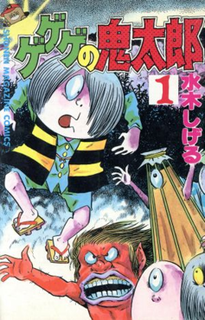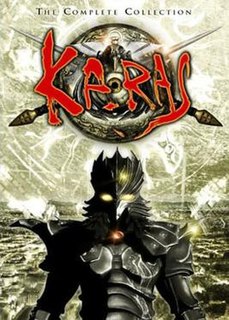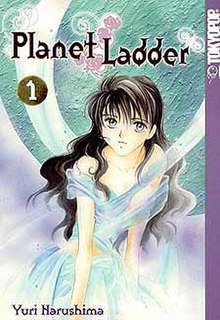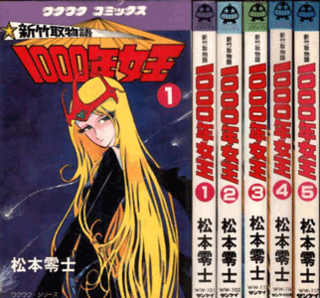 W
WBlood Reign: Curse of the Yoma , also known as Curse of the Undead: Yoma, is a Japanese manga written and illustrated by Kei Kusunoki. The manga was serialized in Shueisha's manga magazine Ribon Original from 1985 to 1986. The individual chapters were collected into a one-shot bound volume by Shueisha on February 18, 1998. The manga was adapted into an original video animation by Takashi Anno.
 W
WBlue Seed is a Japanese manga series written and illustrated by Yuzo Takada. The plot is based on the Izumo cycle of Japanese mythology. The main character, Momiji Fujimiya, is a descendant of the mythical Princess Kushinada . When Japan is menaced by Aragami spawned by Yamata no Orochi, Momiji is intended to be sacrificed to appease the Aragami. She instead, however, becomes a member of the Terrestrial Administration Center (TAC), a secret agency charged with fighting them.
 W
WCeres, Celestial Legend, known in Japan as The Mystery of Ceres , is a fantasy shōjo manga series written by Yuu Watase. It was originally serialized in Shōjo Comic from May 1996 through March 2000 and later reprinted by Shogakukan in fourteen collected volumes.
 W
WCrescent Moon is the English title of the shōjo manga Mikan no Tsuki ), written by Haruko Iida in partnership with Red Company. It was originally published by Kadokawa Shoten beginning in 1999 and serialized in Asuka Comics, and it was translated into English by Tokyopop. It is collected in six volumes.
 W
WDemon Slayer: Kimetsu no Yaiba is a Japanese manga series written and illustrated by Koyoharu Gotouge. It follows teenage Tanjiro Kamado, who strives to become a demon slayer after his family was slaughtered and his younger sister Nezuko turned into a demon. It was serialized in Shueisha's shōnen manga magazine Weekly Shōnen Jump from February 2016 to May 2020, with its chapters collected in twenty-three tankōbon volumes. It has been published in English by Viz Media and simultaneously published by Shueisha on their Manga Plus platform.
 W
WDragon Ball is a Japanese anime television series produced by Toei Animation. It is an adaptation of the first 194 chapters of the manga of the same name created by Akira Toriyama, which were published in Weekly Shōnen Jump from 1984 to 1995. The anime is composed of 153 episodes that were broadcast on Fuji TV from February 1986 to April 1989. It was broadcast in 81 countries worldwide. It is part of the Dragon Ball media franchise.
 W
WDragon Ball GT is a 1996–1997 Japanese anime series based on Akira Toriyama's Dragon Ball manga. Produced by Toei Animation, the series premiered in Japan on Fuji TV and ran for 64 episodes from February 1996 to November 1997. Unlike the previous two anime in the Dragon Ball franchise, Dragon Ball GT does not adapt the manga by Toriyama but is an anime-exclusive sequel show to the Dragon Ball Z anime with an original story using the same characters and universe, which follows the exploits of Goku, his granddaughter Pan, and their various associates. However, Toriyama had designed some of the new characters introduced to the show.
 W
WDragon Ball Z is a Japanese anime television series produced by Toei Animation. Part of the Dragon Ball media franchise, it is the sequel to the 1986 Dragon Ball anime series and adapts the latter 325 chapters of the original Dragon Ball manga series created by Akira Toriyama, which ran in Weekly Shōnen Jump from 1988 to 1995. The series aired in Japan on Fuji TV from April 1989 to January 1996 and was later dubbed for broadcast in at least 81 countries worldwide.
 W
WDream Saga is a shōjo manga by Megumi Tachikawa. From the February 1997 issue to the June 1999 issue, it appeared as a serial in the Japanese manga magazine Nakayoshi. Kodansha compiled the twenty-seven chapters into five bound volumes and published them from October 1997 to September 1999.
 W
WThe Eccentric Family is a Japanese novel written by Tomihiko Morimi, originally published by Gentosha in 2007, with a sequel published in 2015. An anime television series adaptation based on the first book aired from July to September 2013 and was simulcast by Crunchyroll. A second season based on the second book aired from April to June 2017.
 W
WGeGeGe no Kitarō (ゲゲゲの鬼太郎), originally known as Hakaba Kitarō , is a Japanese manga series created in 1960 by Shigeru Mizuki. It is best known for its popularization of the folklore creatures known as yōkai, a class of spirit-monster which all of the main characters belong to. This story was an early 20th-century Japanese folk tale performed on kamishibai. It has been adapted for the screen several times, as anime, live action, and video games. The word GeGeGe (ゲゲゲ) in the title is Japanese sound symbolism for a cackling noise.
 W
WInuyasha is a Japanese manga series written and illustrated by Rumiko Takahashi. The series begins with Kagome Higurashi, a fifteen-year-old middle school girl from modern-day Tokyo who is transported to the Sengoku period after falling into a well in her family shrine, where she meets the half-dog demon, half-human Inuyasha. After the sacred Shikon Jewel re-emerges from deep inside Kagome's body, she accidentally shatters it into dozens of fragments that scatter across Japan. Inuyasha and Kagome set to recover the Jewel's fragments, and through their quest they are joined by the lecherous monk Miroku, the demon slayer Sango, and the fox demon Shippo. Together, they journey to restore the Shikon Jewel before it falls into the hands of the evil half-demon Naraku.
 W
WKakurenbo: Hide & Seek is a Japanese cel-shaded anime short film written and directed by Shuhei Morita.
 W
WKamichu! (かみちゅ!) is a Japanese anime television series, strongly influenced by Shinto, that follows the adventures of teenage goddess Yurie Hitotsubashi and her friends. The title is short for Kamisama de Chūgakusei . The series was created by Besame Mucho , which is the joint pen name of producer Tomonori Ochikoshi, director Koji Masunari, and writer Hideyuki Kurata. It was broadcast by the anime television network Animax on its respective networks worldwide, including Japan, East Asia, South Asia, Southeast Asia, where it received its first English-language broadcast.
 W
WKanokon (かのこん) is a Japanese light novel series by Katsumi Nishino, with illustrations by Koin. The first novel was released by Media Factory on October 31, 2005 under its MF Bunko J imprint, and it published 15 volumes until December 24, 2010. A manga adaptation illustrated by Rin Yamaki was serialized in Media Factory's seinen manga magazine Monthly Comic Alive between the August 2006 and August 2010 issues. A drama CD was produced by Media Factory and released on March 28, 2007. A twelve-episode anime adaptation produced by Xebec aired in Japan between April and June 2008 on AT-X, and has been licensed by Media Blasters for release in North America. A two-part OVA sequel aired on AT-X in October 2009. A visual novel named Kanokon Esuii developed by 5pb. was released for the PlayStation 2 on July 31, 2008.
 W
WKaras is a Japanese six-part original video animation series. Tatsunoko Productions produced it to commemorate its 40th anniversary of anime production. Each Karas episode was first televised in Japan as a pay-per-view program from March 25, 2005, to August 3, 2007, before being released onto DVDs. Manga Entertainment compiled and released these episodes as two feature length, direct-to-DVD films for the English market.
 W
WKarasu Tengu Kabuto is a Japanese manga series written and illustrated by Buichi Terasawa in 1987.
 W
WKon Kon Kokon is a Japanese manga series written and illustrated by Koge-Donbo. The manga is in serialisation in Broccoli Books's magazine, Comi Digi +. In North America, the manga was released by Broccoli Books USA. It is about a boy named Ren who just wants to be one of the cool kids, but he secretly is a nerdy monster fanatic. That is, until a young girl named Kokon shows up. She claims to be a fox that he had helped years ago, and now she wants to return the favor.
 W
WKonohana Kitan (このはな綺譚) is a Japanese manga series by Sakuya Amano. Originally published in Ichijinsha's yuri manga magazine Comic Yuri Hime S under the name Konohana-tei Kitan (此花亭奇譚) between 2009 and 2010 before going on hiatus, the series relaunched in Gentosha's seinen manga magazine Comic Birz in December 2014. The manga is licensed in English by Tokyopop. A 12-episode anime television series adaptation by Lerche aired in Japan between October and December 2017.
 W
WThe Little Prince and the Eight-Headed Dragon is a Japanese animated fantasy adventure film, the 6th feature produced by Toei Animation, released in Japan on March 24, 1963. English-dubbed versions have been released under several titles, including The Little Prince and the Eight-Headed Dragon, Prince in Wonderland and Rainbow Bridge.
 W
WLu over the Wall is a 2017 Japanese animated fantasy film produced by Science Saru and released by Toho about the eponymous ningyo. It was directed by Masaaki Yuasa, and written by Yuasa and Reiko Yoshida. The music was composed by Takatsugu Muramatsu. It is the second Science Saru film, though it was the first to be produced.
 W
WMy Neighbor Totoro is a 1988 Japanese animated fantasy film written and directed by Hayao Miyazaki and animated by Studio Ghibli for Tokuma Shoten. The film—which stars the voice actors Noriko Hidaka, Chika Sakamoto, and Hitoshi Takagi—tells the story of a professor's two young daughters and their interactions with friendly wood spirits in post-war rural Japan. The film won the Animage Anime Grand Prix prize and the Mainichi Film Award and Kinema Junpo Award for Best Film in 1988. It also received the Special Award at the Blue Ribbon Awards in the same year.
 W
WNaruto is a Japanese manga series written and illustrated by Masashi Kishimoto. It tells the story of Naruto Uzumaki, a young ninja who seeks recognition from his peers and dreams of becoming the Hokage, the leader of his village. The story is told in two parts – the first set in Naruto's pre-teen years, and the second in his teens. The series is based on two one-shot manga by Kishimoto: Karakuri (1995), which earned Kishimoto an honorable mention in Shueisha's monthly Hop Step Award the following year, and Naruto (1997).
 W
WNew Getter Robo is an anime original video animation co-produced by Dynamic Planning and Bandai Visual. The series is a re-imagining of the 1970s manga Getter Robo, created by Go Nagai and Ken Ishikawa, that incorporates aspects of Japanese mythology like the Oni and Abe no Seimei which replaces the Dinosaur and Hyakki Empire present in the original Getter Robo manga.
 W
WOmamori Himari , also known as OmaHima (おまひま) for short, is a Japanese manga series written and illustrated by Milan Matra. The story revolves around Yuto Amakawa, an orphan who, on his sixteenth birthday, meets Himari, a cat spirit samurai girl who has sworn an oath to protect Yuto from the various monsters and demons that are out to kill him.
 W
WPlanet Ladder is a Japanese manga series written and illustrated by Yuri Narushima. Appearing as a serial in the shōjo manga magazine Crimson from the March 1998 issue to the May 2003 issue, the chapters of Planet Ladder were published by Sobisha/Shueisha in seven tankōbon volumes from December 1998 to May 2004. Based on the Japanese folktale The Tale of the Bamboo Cutter in which a girl is discovered to be the princess of the moon, the story focuses on a teenager named Kaguya, who is prophesied to save only one of the nine parallel worlds, and her quest to bring peace to a warring universe while finding her true identity.
 W
WPom Poko is a 1994 Japanese animated fantasy film directed by Isao Takahata, animated by Studio Ghibli for Tokuma Shoten, Nippon Television Network and Hakuhodo, and distributed by Toho.
 W
WQueen Millennia is a manga series by Leiji Matsumoto which was serialized from 28 January 1980 through 11 May 1983 in both the Sankei Shimbun and Nishinippon Sports newspapers. The manga series was adapted into a 42-episode anime television series by Toei Dōga and broadcast on the Fuji TV network from 16 April 1981 through 25 March 1982. An anime film was released on 13 March 1982 shortly before the TV series ended.
 W
WShirahime-Syo: Snow Goddess Tales is a supernatural manga by Clamp, a creative team made up by Satsuki Igarashi, Nanase Ohkawa, Tsubaki Nekoi and Mokona. It consists of three short stories, framed by a man's encounter with the titular character in the snow. The character design of the title character originated in a postcard in the team's newsletters, and later appeared in a preview page in the March 1992 issue of Bar Pretty, when only the concept had been finalized. Completed on a "tight" schedule, the volume was published in June 1992 by Kobunsha, and re-released in August 2001 by Kadokawa Shoten.
 W
WSpirited Away is a 2001 Japanese animated fantasy film written and directed by Hayao Miyazaki, animated by Studio Ghibli for Tokuma Shoten, Nippon Television Network, Dentsu, Buena Vista Home Entertainment, Tohokushinsha Film, and Mitsubishi. The film features the voices of Rumi Hiiragi, Miyu Irino, Mari Natsuki, Takeshi Naito, Yasuko Sawaguchi, Tsunehiko Kamijō, Takehiko Ono, and Bunta Sugawara. Spirited Away tells the story of Chihiro Ogino (Hiiragi), a ten-year-old girl who, while moving to a new neighborhood, enters the world of Kami. After her parents are turned into pigs by the witch Yubaba (Natsuki), Chihiro takes a job working in Yubaba's bathhouse to find a way to free herself and her parents and return to the human world.
 W
WTakeru: Letter of the Law is a video game based on the manga series by Buichi Terasawa. It was originally released by Matsushita Electric Industrial for the 3DO Interactive Multiplayer only in Japan as Terasawa Buichi no Takeru (寺沢武一の武), before being converted to the Microsoft Windows and Mac OS computer systems and published internationally Takeru: Letter of the Law and Buichi Terasawa's Takeru in 1996. The manga was published in English in 1992-1993 as Takeru - The Bad Boy of Yamato.
 W
WThe Everyday Tales of a Cat God , also known as Cat God, is a Japanese manga series written and illustrated by Flipflops about a cat goddess that lives in an antique shop. An anime television adaptation by AIC PLUS+ aired in Japan between July and September 2011 and has been licensed in North America by NIS America.
 W
WUrusei Yatsura (うる星やつら) is a Japanese manga series written and illustrated by Rumiko Takahashi and serialized in Shogakukan's Weekly Shōnen Sunday from 1978 to 1987. Its 374 individual chapters were published in 34 tankōbon volumes. It tells the story of Ataru Moroboshi, and the alien Lum, who believes she is Ataru's wife after he accidentally proposes to her. The series makes heavy use of Japanese mythology, culture and puns. It was adapted into an anime television series produced by Kitty Films and broadcast on Fuji Television affiliates from 1981 to 1986 with 195 episodes. Twelve OVAs and six theatrical films followed, and the series was released on VHS, Laserdisc, DVD, and Blu-ray Disc in Japan.
 W
WYo-kai Watch is a Japanese mixed-media franchise of Japanese role-playing video games and toys, created and developed by Level-5. The toys then led reran by Hasbro in North America. The first game in the series was released for the Nintendo 3DS in 2013. Three main sequels and several spinoffs, on both Nintendo and mobile platforms, have been released. In December 2019, they expanded to PlayStation with the release of Yo-kai Watch 4++.
 W
WYo-kai Watch Shadowside is a supernatural anime series produced by OLM. It is the sequel to the 2017 film Yo-kai Watch Shadowside: Oni-ō no Fukkatsu and a proper sequel to the original Yo-kai Watch anime series, originally based on the games created by Level-5. Yōichi Katō returned to officially direct and write the anime alongside new staff. It premiered in all TXN Stations in Japan from April 13, 2018 to March 29, 2019. It was replaced by the 2019 Yo-kai Watch! series in the same timeslot.
 W
WYōkaiden is an original English-language manga written and illustrated by Nina Matsumoto and published by Del Rey Manga. The story features Hamachi, a boy fascinated by the Japanese monsters called yokai. When one of these monsters steals his grandmother's soul, he travels into their world to retrieve it. The first volume was published on November 18, 2008, and as of November 24, 2009, two volumes were released.
 W
WYōtōden is a 3-episode Japanese original video animation produced by J.C.Staff, the studio's first production. In 1989, Yōtōden was re-edited into a feature film version titled Wrath of the Ninja for English-speaking regions, but is currently out of print. A manga adaptation was serialized in Newtype.